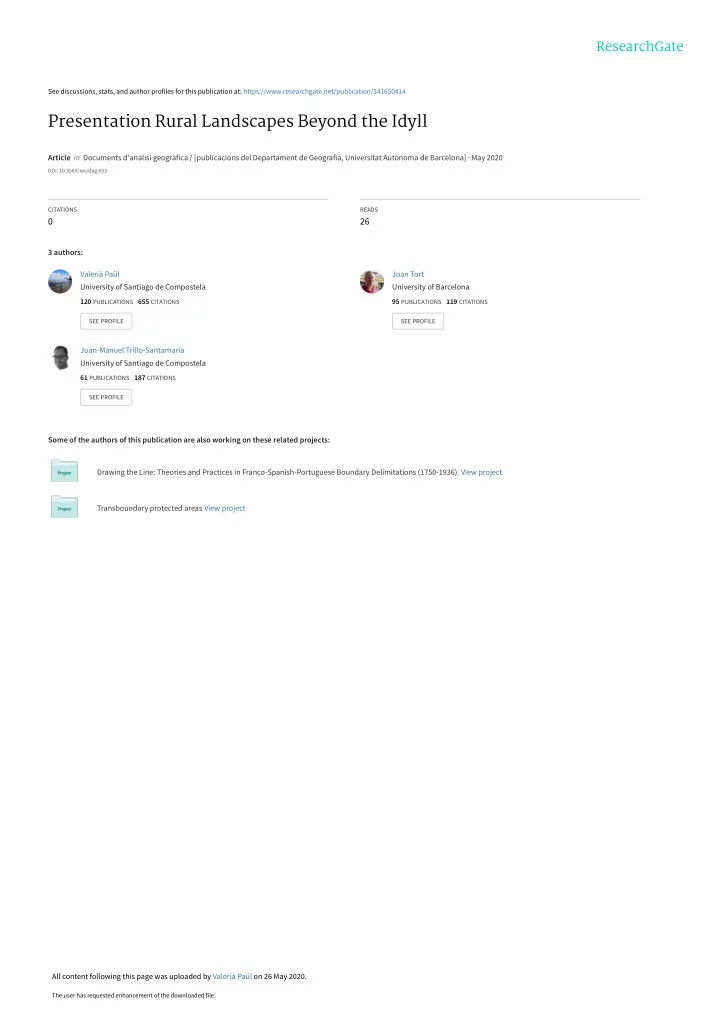

See discussions, stats, and author profiles for this publication at: https://www.researchgate.net/publication/341650414 Presentation Rural Landscapes Beyond the Idyll Article in Documents d'anàlisi geogràfica / [publicacions del Departament de Geografia, Universitat Autònoma de Barcelona] · May 2020 DOI: 10.5565/rev/dag.653 CITATIONS READS 0 26 3 authors: Valerià Paül Joan Tort University of Santiago de Compostela University of Barcelona 120 PUBLICATIONS 655 CITATIONS 95 PUBLICATIONS 119 CITATIONS SEE PROFILE SEE PROFILE Juan-Manuel Trillo-Santamaría University of Santiago de Compostela 61 PUBLICATIONS 187 CITATIONS SEE PROFILE Some of the authors of this publication are also working on these related projects: Drawing the Line: Theories and Practices in Franco-Spanish-Portuguese Boundary Delimitations (1750-1936). View project Transboundary protected areas View project All content following this page was uploaded by Valerià Paül on 26 May 2020. The user has requested enhancement of the downloaded file.
Documents d’Anàlisi Geogràfica 2020, vol. 66/2 245-255 Presentation Rural Landscapes Beyond the Idyll 1. Rural Landscapes from a Geographical Perspective Geography as a discipline has purposely studied rural landscapes since at least its early modern period. In 1801, for instance, the founder of geographical science in its contemporary dimension, Alexander von Humboldt, when trave- ling in the Cauca region (currently South-Western Colombia, at that time belonging to the Viceroyalty of New Granada), described the process by which the Coconuco Indians had been expelled from the fertile plains – where the city of Popayán was founded by the Spanish conquerors – and forcibly dis- placed to the inclined slopes of the Puracé volcano. Agriculture was tough in these highlands because of the squalid soils and freezing climate, “where the frost kills their potatoes, cabbage and onion crops, while they watch how the most beautiful fields of wheat grow in their former lands of mild and more benign climate” ( apud Avendaño, 2015: 19; our translation). Narratives of this type expressively capture Humboldt’s ‘landscape style’ (Ortega Cantero, 2004; Gómez Mendoza, 2008; López Silvestre, 2009), here, in reference to a rural area and, interestingly, describing a process of colo- nial dispossession. Importantly, in Humboldtian landscapes we not only find reflections on their material or tangible features (e.g. the contrast between the ravaged potato fields on the slopes and the fields of ripe wheat in the plains), but also the author’s associated perceptions, feelings and even imaginations – i.e. the open condemnation of colonial processes, including an apparently empathetic complicity with the feelings of the Coconuco Indians as they look back at their old lands from the mountain slopes. The study of rural landscapes peaked in geography with the French Region- al School in the early decades of the 20 th century. During this period, regions, in particular in the case of France at the level of the pays (a supra-local scale https://doi.org/10.5565/rev/dag.653 ISSN 0212-1573 (imprès), ISSN 2014-4512 (en línia)
Presentació that might be roughly translated into English as county ), were described as possessing a particular rural landscape: this was assumed to consist of a charac- teristic pattern of elements perfectly adapted to the environmental conditions of the area (Buttimer, 1971; García Álvarez, 2006; Lencioni, 2009). On occa- sion, the term rural landscape would even be alluded to literally. For instance, in Vidal’s ground-breaking Tableau , the different pays of the Garonne basin were described as follows: The marls have by designation formed what are called ‘strong lands’ [ terres fortes ], lands of wheat which for more than two thousand years have never ceased to deliver their harvests. The fields dominate the physiognomy; they occupy the rounded knolls, run down the slopes, in places interrupted by small coppiced woods. The trees, especially in the bizarre form of pollard oaks, appear here and there […]. (Vidal de la Blache, 1903 [ed. 1994]: 521; our translation) Landscape characterisations of this kind were, for many decades, typical in geography and have been reappraised in the contemporary context in recently developed approaches, such as that of the “Landscape Character Assessment”. This method, developed in the British Isles in the early 2000s, is concerned with “identifying areas of similar character, classifying and mapping them and describing their character”, where character is understood as “[a] distinct, recognisable and consistent pattern of elements in the landscape that makes one landscape different from another” (Swanwick, 2002: 8). In this sense, it seems that the Vidalian school in its day framed a particular way of unders- tanding landscapes, in particular rural landscapes. Interestingly, several authors have evidenced that French rural landscapes as conceived by Vidal were not a simple material object waiting to be accurately described by the geographer, but an immanent national discourse about the identity of France (Ortega Cantero, 2005). However, this subtle, intangible reading was mainly non-explicit and perhaps derives from subsequent analysis. In any case, it informs us of the fact that landscapes cannot be solely conceived as material entities and that, frequently, they are used in national and natio- nalist narratives. In the English-speaking world, the Vidalian approach is largely unknown despite Buttimer’s (1971) book about the French Regional School; and, yet, a similar perspective was developed by Sauer (1925), who achieved considerable popularity in Anglophone geography. Sauer’s landscape morphological method sought to understand the sequence of historical cultural layers that influence the configuration of the landscape conceived as a material construction. Rural landscapes were often seen to constitute the “perfect” type of landscape for such analysis, agricultural geography (crops, field borders, hedgerows, etc.) being central to the Sauerian approach to landscape studies. Sauer (1925: 48) quoting Humboldt, acknowledged that “The best geography has never disre- garded the aesthetic qualities of landscape”. However, he considered Hum- boldtian landscape as “beyond science”, applying “the subjective approach” 246 Documents d’Anàlisi Geogràfica 2020, vol. 66/2
Recommend
More recommend